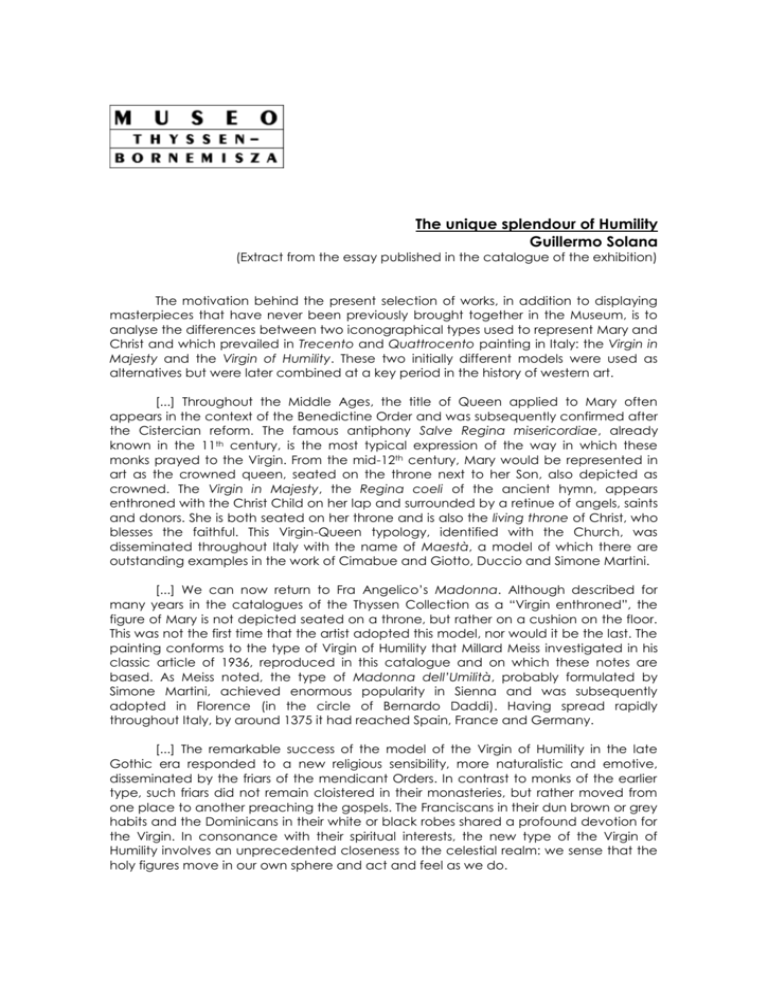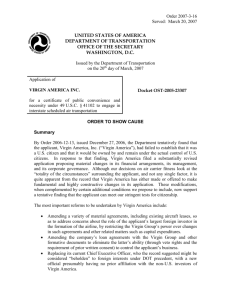The unique splendour of Humility - Museo Thyssen
advertisement

The unique splendour of Humility Guillermo Solana (Extract from the essay published in the catalogue of the exhibition) The motivation behind the present selection of works, in addition to displaying masterpieces that have never been previously brought together in the Museum, is to analyse the differences between two iconographical types used to represent Mary and Christ and which prevailed in Trecento and Quattrocento painting in Italy: the Virgin in Majesty and the Virgin of Humility. These two initially different models were used as alternatives but were later combined at a key period in the history of western art. [...] Throughout the Middle Ages, the title of Queen applied to Mary often appears in the context of the Benedictine Order and was subsequently confirmed after the Cistercian reform. The famous antiphony Salve Regina misericordiae, already known in the 11th century, is the most typical expression of the way in which these monks prayed to the Virgin. From the mid-12th century, Mary would be represented in art as the crowned queen, seated on the throne next to her Son, also depicted as crowned. The Virgin in Majesty, the Regina coeli of the ancient hymn, appears enthroned with the Christ Child on her lap and surrounded by a retinue of angels, saints and donors. She is both seated on her throne and is also the living throne of Christ, who blesses the faithful. This Virgin-Queen typology, identified with the Church, was disseminated throughout Italy with the name of Maestà, a model of which there are outstanding examples in the work of Cimabue and Giotto, Duccio and Simone Martini. [...] We can now return to Fra Angelico’s Madonna. Although described for many years in the catalogues of the Thyssen Collection as a “Virgin enthroned”, the figure of Mary is not depicted seated on a throne, but rather on a cushion on the floor. This was not the first time that the artist adopted this model, nor would it be the last. The painting conforms to the type of Virgin of Humility that Millard Meiss investigated in his classic article of 1936, reproduced in this catalogue and on which these notes are based. As Meiss noted, the type of Madonna dell’Umilità, probably formulated by Simone Martini, achieved enormous popularity in Sienna and was subsequently adopted in Florence (in the circle of Bernardo Daddi). Having spread rapidly throughout Italy, by around 1375 it had reached Spain, France and Germany. [...] The remarkable success of the model of the Virgin of Humility in the late Gothic era responded to a new religious sensibility, more naturalistic and emotive, disseminated by the friars of the mendicant Orders. In contrast to monks of the earlier type, such friars did not remain cloistered in their monasteries, but rather moved from one place to another preaching the gospels. The Franciscans in their dun brown or grey habits and the Dominicans in their white or black robes shared a profound devotion for the Virgin. In consonance with their spiritual interests, the new type of the Virgin of Humility involves an unprecedented closeness to the celestial realm: we sense that the holy figures move in our own sphere and act and feel as we do. Despite the innovative spirituality which this type represented, the Virgin of Humility was not lacking in pictorial precedents. [...] For Meiss, the group of Mary and the Christ Child in the Nativity scenes by Daddi and Taddeo Gaddi reveals a profound affinity with the Virgin of Humility type and was furthermore its principal source. The Mother and Child then disengaged themselves from the narrative composition of the Nativity to become a separate devotional image. [...] As Meiss observed, “the Virgin is the Regina coeli and also the Nostra domina de humilitate, and thus Regina humilitatis”. This dialectic which combines the high and the low, the humble and the sublime, is marvellously represented in the Thyssen Maddona. While the throne itself has disappeared, Fra Angelico’s Virgin has other attributes of her royal majesty such as the rich embroidered cloth of honour which covered the throne of the Virgins in Majesty, the pedestal on which she is elevated, the attentive trio of angels above and the music from the two below, which rises up towards her. Adorned with these attributes and transfigured by the very colours of the panel, this round-faced young woman appears before us as simultaneously simple and solemn, earthly and celestial, radiant with the unique splendour of her Humility.






![creative brief[1].doc](http://s3.studylib.net/store/data/008020167_1-bbbb85bf421ecbf5c184ba55e73c6c23-300x300.png)


